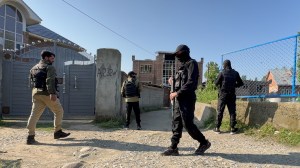Mumbai: Street dedicated to community that formed first police force
Bhandari is a caste and the community hails from the western coast of India. The community lives in parts of Maharashtra, Goa and Karnataka. The community that is among Other Backward Classes (OBC) in Maharashtra hails primarily from the Konkan region.
 Bhandari street
Bhandari street
THE BHANDARI Street at Kumbharwada in south Mumbai is a testament to the Bhandari community that has inhabited the city for over three centuries. The community has a special connection to the city: the Bhandari Militia, comprising members of the community, was the first police establishment in Mumbai — then Bombay — under the British East India Company. The Bandareens — as the British called them — who were well built and comprising primarily of toddy tappers, were first tasked with keeping an eye on robbers and burglars. Today, however, there are hardly any members of the community that stay on Bhandari street with most of them having sold their houses and left for cheaper abodes north of the city.
Bhandari is a caste and the community hails from the western coast of India. The community lives in parts of Maharashtra, Goa and Karnataka. The community that is among Other Backward Classes (OBC) in Maharashtra hails primarily from the Konkan region.
Historian Deepak Rao said, “Bhandaris were essentially toddy tappers. Bhandari Militia formed out of members of the Bhandari community was the first police establishment during the time of the East India Company. In Bombay, it was Governor Aungier who formed a militia of youngsters from the local Bhandari community to deal with street gangs that robbed sailors in the 1660s.” He added, “In the 50s there were several colonies of Bhandaris including those in central Mumbai. Over a period of time, however, they moved out.”
In his book, The Bombay City Police — A historical sketch 1672-1916, S M Edwardes writes that the Bhandari Militia policed the city from 1672-1800. He writes that 1800 to 1855 was the period of Magistracy before Sir Frank Souter was appointed a full time police commissioner in 1864 after Charles Forjett’s tenure as the acting commissioner. Edwardes writes, “Amidst the heavy duties which devolved upon him (Aungier) as President of Surat and Governor of the Company’s recently acquired island (Charles II had transferred Bombay to the East India Company in 1668) Aungier found leisure to organize a rude militia under the command of Subhedars, who were posted at Mahim, Sewri, Sion and other chief points of the Island.”
 The Bhandari street on the east of Gol Deval or round temple now has become a metal market.
The Bhandari street on the east of Gol Deval or round temple now has become a metal market.
The Bhandari street that is the first of the six Kumbharwada lanes on the east side of the Gol Deval (round temple) now has become a metal market. As one walks on the nearly 500 metre stretch, there is a string of shops primarily selling metal, and a few cloth stores.
Ehsan Ali, who owns a cloth shop at the beginning of the lane since 1958 said that earlier there were several members of the Bhandari community who later took up odd jobs, started leaving the street since the early 2000s. “Majority of them sold their houses here since it fetched them better prices. They then moved northwards like Virar, Nallasopara and Vasai. Now there are few of them here. Now most of the people occupying the streets are Marwaris from Rajasthan and north Indians,” Ali told The Indian Express.
Sunil Sawnat, who owns a cloth shop on the street said, “While majority of them have left, there are still some markers of the community left behind like a community hall used by them.”












